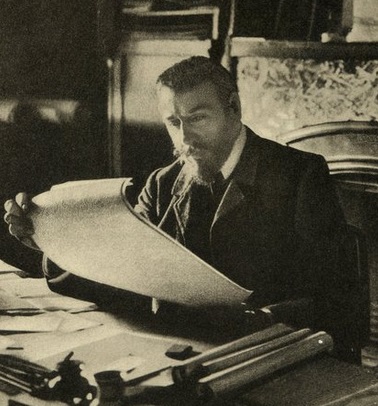Victor Horta
 Victor Pierre Horta (; Victor, Baron Horta after 1932; 6 January 1861 – 8 September 1947) was a Belgian architect and designer, and one of the founders of the Art Nouveau movement. He was a fervent admirer of the French architectural theorist Eugène Viollet-le-Duc and his Hôtel Tassel in Brussels (1892–93), often considered the first Art Nouveau house, is based on the work of Viollet-le-Duc. The curving stylized vegetal forms that Horta used in turn influenced many others, including the French architect Hector Guimard, who used it in the first Art Nouveau apartment building he designed in Paris and in the entrances he designed for the Paris Metro. He is also considered a precursor of modern architecture for his open floor plans and his innovative use of iron, steel and glass.
Victor Pierre Horta (; Victor, Baron Horta after 1932; 6 January 1861 – 8 September 1947) was a Belgian architect and designer, and one of the founders of the Art Nouveau movement. He was a fervent admirer of the French architectural theorist Eugène Viollet-le-Duc and his Hôtel Tassel in Brussels (1892–93), often considered the first Art Nouveau house, is based on the work of Viollet-le-Duc. The curving stylized vegetal forms that Horta used in turn influenced many others, including the French architect Hector Guimard, who used it in the first Art Nouveau apartment building he designed in Paris and in the entrances he designed for the Paris Metro. He is also considered a precursor of modern architecture for his open floor plans and his innovative use of iron, steel and glass.Horta's later work moved away from Art Nouveau, and became more geometric and formal, with classical touches, such as columns. He made a highly original use of steel frames and skylights to bring light into the structures, open floor plans, and finely-designed decorative details. His later major works included the Maison du Peuple/Volkshuis (1895–1899), Brussels' Centre for Fine Arts (1923–1929) and Brussels-Central railway station (1913–1952). In 1932, King Albert I conferred on Horta the title of Baron for his services to the field of architecture.
After Art Nouveau lost favor, many of Horta's buildings were abandoned, or even destroyed, though his work has since been rehabilitated. Four of the buildings he designed in Brussels were added to the UNESCO World Heritage List in 2000: the Hôtel Tassel, the Hôtel Solvay, the Hôtel van Eetvelde and the Horta House (currently the Horta Museum). Provided by Wikipedia
1
Published: 1996
Superior document: Mémoires de la Classe de Beaux-Arts / Académie Royale de Belgique : Collection in-8° Sér. 3, 11
